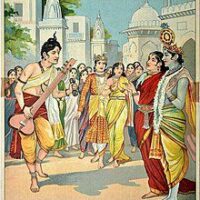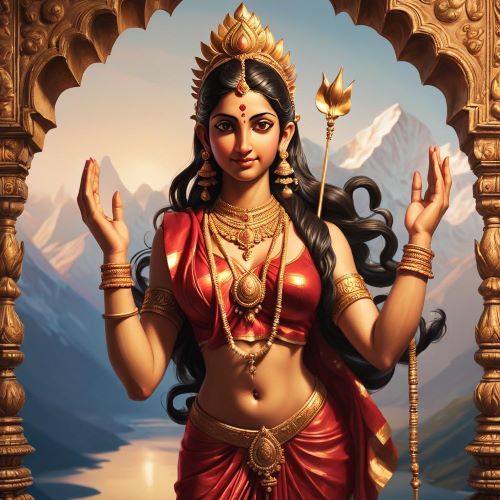Rati : Goddess of Love
Listen
At a glance
| Description | |
|---|---|
| Origin | Indian Mythology |
| Classification | Gods |
| Family Members | Kamadeva (Husband), Prajapati Daksha (Father) |
| Region | India |
| Associated With | Love, Lust, Desire |
Rati
Introduction
In Indian mythology, Rati is a prominent deity symbolizing love, desire, and passion, closely associated with Kamadeva, the god of love. Her mythological narrative revolves around themes of romance, devotion, and the interplay of attraction and fulfillment. As Kamadeva’s consort, Rati is revered for her role in kindling love among gods and mortals alike. She is depicted as the daughter of Prajapati Daksha and serves as Kamadeva’s chief consort and aide, embodying the essence of love, carnal desire, and pleasure in Hindu tradition.
Physical Traits
Rati is depicted as a radiant goddess adorned with symbols of fertility and sensuality. Her beauty is described vividly in scriptures, portraying her as a young maiden with an otherworldly charm. Her skin resembles freshly bloomed jasmine, emitting a celestial glow, complemented by large, expressive eyes likened to lotus blossoms that reflect deep emotions. Her raven hair flows like a waterfall, adorned with fragrant jasmine flowers, enhancing her grace with every movement. Rati’s laughter is likened to the tinkling of temple bells, embodying sensuality and captivating allure. Artists and sculptors emphasize her irresistible physical attractiveness, depicting her as the embodiment of beauty and enchantment, even to the God of Love himself.
Family
Rati traces her lineage to Prajapati Daksha, portrayed as his daughter in Hindu mythology. Legend has it that she emerged from Daksha’s sweat, symbolizing the potent energy of desire, a connection that underscores the intense and raw nature of passion embodied by Rati. Her divine match is Kamadeva, the God of Love, with whom she shares a profound bond. Rati is not only Kama’s beloved consort but also his muse and confidante. Together, they wield their enchantment to spread love and joy throughout the world, symbolizing the harmonious interplay of desire and fulfillment that transcends mortal boundaries.
Other names
Rati is known by various names across Hindu texts, each highlighting different aspects of her divine essence. She is affectionately called Kamavallabhi, signifying her as the beloved of Kama, and Priti, denoting her association with pleasure and delight. Additionally, she is recognized as Ragini, the queen of emotions, and Kameshwari, the goddess who presides over love. In some narratives, she assumes the name Mayavati, emphasizing her nurturing role in the upbringing of Pradyumna, the son of Krishna and Rukmini, underscoring her connection to Kama’s rebirth. These names collectively reveal Rati’s multifaceted nature, representing not only physical desire but also the deep emotional bonds and joy that love engenders across different traditions and texts.
Powers and Abilities
Rati’s influence transcends mere physical allure, encompassing realms of love, passion, and desire. Following Kama’s incineration by Shiva, it is Rati’s fervent prayers that ultimately lead to his resurrection, showcasing her unwavering devotion and pivotal role in restoring the God of Love to life. Endowed with supernatural abilities, Rati can intensify the potency of love and desire, imbuing hearts of both gods and mortals with passion that shapes destinies and forges enduring bonds across lifetimes. Her presence is invoked in rituals and prayers seeking to ignite romance, strengthen relationships, and nurture emotional intimacy.
As the Goddess of Love, Rati exudes a captivating aura that inspires attraction and desire, capable of awakening dormant flames within hearts. She possesses the ability to weave illusions that captivate even the most impassive, with her laughter holding a mesmerizing effect and her seductive dance entrancing even the gods. Armed with a divine bow and flower arrows like Kamadeva, Rati’s approach is gentler, symbolizing the natural blossoming of desire and the enchanting power of feminine allure.
Modern Day Influence
Rati’s influence transcends ancient scriptures, resonating strongly in modern contexts as a potent symbol of love and desire. In classical Indian dance forms like Bharatanatyam, her divine allure is vividly portrayed through expressive gestures and captivating poses, often alongside Kamadeva in traditional Indian paintings. Beyond art, Rati remains a profound source of inspiration, emphasizing the importance of embracing love and passion as essential elements of the human experience. Amid a world often driven by practicality, her story underscores the transformative impact of love.
The concept of “Rati Bhava,” exploring the emotional state of love and desire, continues to be studied in Indian philosophy and spiritual practices. In contemporary culture, Rati’s influence endures through diverse artistic interpretations and cultural expressions that delve into the complexities of human relationships. Devotees invoke her blessings during Hindu worship and festivals, seeking harmony in partnerships and celebrating the union of souls. Though not as widely worshiped as major deities, Rati’s essence continues to inspire artists, poets, and romantics alike, symbolizing the compelling potency of love and its ability to transcend mortal limitations.
Related Images
Frequently Asked Questions
What is lorem Ipsum?
I am text block. Click edit button to change this text. Lorem ipsum dolor sit amet, consectetur adipiscing elit. Ut elit tellus, luctus nec ullamcorper mattis, pulvinar dapibus leo.
What is lorem Ipsum?
I am text block. Click edit button to change this text. Lorem ipsum dolor sit amet, consectetur adipiscing elit. Ut elit tellus, luctus nec ullamcorper mattis, pulvinar dapibus leo.
What is lorem Ipsum?
I am text block. Click edit button to change this text. Lorem ipsum dolor sit amet, consectetur adipiscing elit. Ut elit tellus, luctus nec ullamcorper mattis, pulvinar dapibus leo.
What is lorem Ipsum?
I am text block. Click edit button to change this text. Lorem ipsum dolor sit amet, consectetur adipiscing elit. Ut elit tellus, luctus nec ullamcorper mattis, pulvinar dapibus leo.
What is lorem Ipsum?
I am text block. Click edit button to change this text. Lorem ipsum dolor sit amet, consectetur adipiscing elit. Ut elit tellus, luctus nec ullamcorper mattis, pulvinar dapibus leo.












